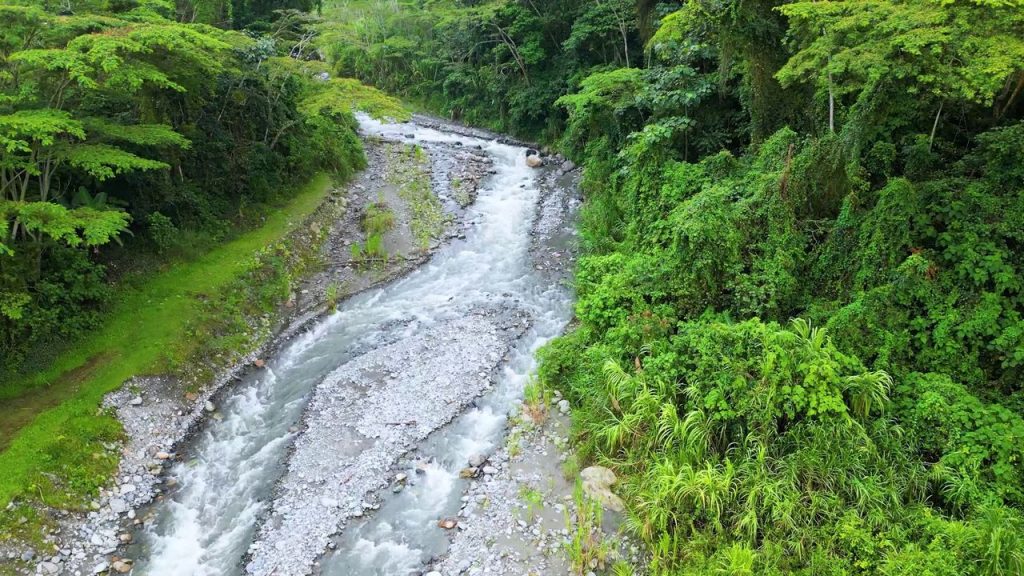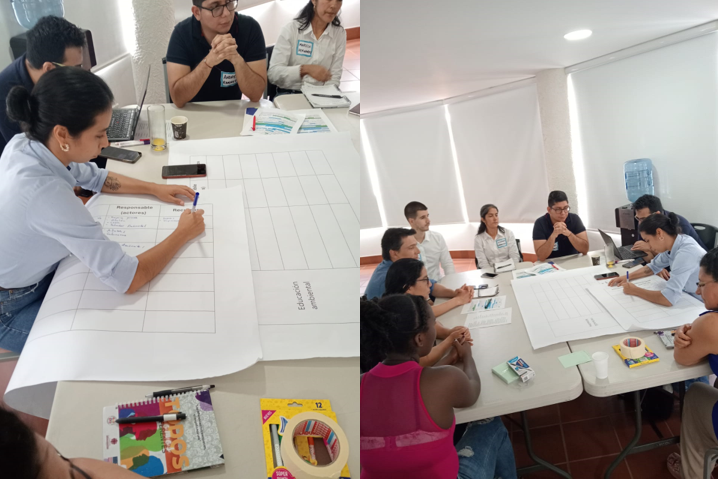On 22 May 2024, 20 stakeholders representing the local municipality, public administration, natural resource managers, environmental organisations, citizens’ organisations and the private sector joined the 4rd REXUS workshop, aimed at elaborating the work plan for reaching a 10-year sustainable future vision for the sub-basin. The workshop was led by Nima river watershed pilot leader, Alliance of Bioversity and CIAT, with contributions from REXUS partners ETIFOR (on Nature-based Solutions and valuation of Ecosystem Services), IRSA (on Participatory System Dynamics Modeling), and iCatalist (on participatory co-creation methodologies).
It was the culmination of the workshops’ goal of developing the territorial vision of the Nima sub-basin in the Municipality of Palmira, which brought together for the first time representatives from different levels of management across the Water-Energy-Food-Ecosystems Nexus sectors in a joint exploration of the area’s challenges and potential solutions.
In the three previous workshops, stakeholders had identified the area’s challenges, then moved on to examine future scenarios and the potential of Nature-based Solution implementation, and then to validate a 5-year sustainability plan. A special workshop with key institutional actors was devoted to examining the implementation of Nature-based Solutions and their integration in local management plans. The entire process was facilitated and informed by REXUS researchers.

A tributary of the Amaime River, that drains into the Cauca River, the Nima river watershed is one of the most important rivers of Colombia. It is located in the southeast of the Department of Cauca Valley, in the Colombian Andes.
The Nima river sub-basin is blessed with valuable ecosystems, including upstream paramo and Andean ecosystems with rich biodiversity, however there are intense competing demands, which put pressure on resources and challenge future sustainability. For example, lack of proper sewerage has been identified by stakeholders as a significant risk upstream in the Nima river, where waste is discharged untreated into the river, endangering the water supply of rural aqueducts managed by local communities. Furthermore, local industry, such as pine plantations for paper production and sugar cane plantations provide employment opportunities for some people, but also place a strain on water resources.
The 4th workshop’s main objective was to elaborate a 5-year Action Plan that will lead the Nima sub-basin to reach the desired long-term vision developed in the previous workshop. This Action Plan includes a series of measures, and maps the activities, involved actors and necessary resources associated with each measure.

Participants listed the measures identified in the long-term vision for the sub-basin, and proposed activities, responsible actors and necessary resources they considered appropriate for each measure, with a 5-year timeframe.
For this exercise, participants split into two groups, both of which blended members from community organizations, NGOs, private companies and public institutions, ensuring that the activities, actors and resources identified for each measure were agreed upon in an inter-institutional manner and with the equal participation of the sub-basin communities.
Of the eight measures identified in the vision, notable ones include Payments for environmental services (PES) scheme, environmental education, agro-ecological practices, preservation of community aqueducts, biodiversity conservation, and ecotourism, among others.

Incentive mechanisms are required in the watershed to align land use/management decisions in the watershed to common environmental and socioeconomic goals of actors.
Among the aspects to be highlighted in the elaborated Action plan is the interest of stakeholders in improving the implementation of measures such as PES scheme. They propose an evaluation to expand the beneficiaries of these schemes, ensuring that social organizations, like aqueduct user associations, are also included. Additionally, the different WEFE Nexus sector representatives agreed on a series of activities to address the challenges of the sub-basin. Some of the main activities include training in sustainable tourism practices, conducting value chain studies of agro-ecological products, upgrading aqueduct infrastructure, such as distribution networks and catchment areas, and carrying out productive reconversion and ecological restoration on select farms, among others.
Following the elaboration of the Action Plan, the next step is to organize a meeting to validate the territorial vision document of the sub-basin. This activity aims to initiate a process of monitoring the implementation of the plan. Subsequently, the Nima river watershed pilot leader evaluate the viability of continuing the stakeholder platform based on the commitment expressed by the stakeholders.
Finally, the last workshop session was led by Etifor, who presented the final results of the economic valuation of some ecosystem services in the sub-basin, based on the modeling of the implementation of one of the prioritized nature-based solutions (NbS): reforestation through the payment for environmental services scheme. This presentation followed an initial meeting where preliminary results were presented to key stakeholders of the sub-basin, allowing for validation of the process and incorporation of suggested adjustments, thus completing the modeling and estimation process for the economic valuation.

